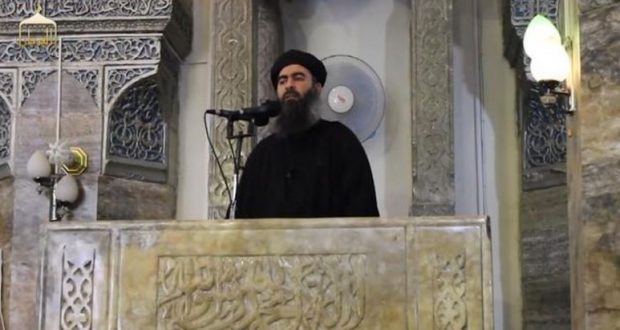The son of ISIS leader Abu Bakr al-Baghdadi was not killed in new attacks by the Organization in the Desert of Homs
The Syrian Observatory for Human Rights continues to monitor military operations, the hit-and-run clashes, artillery, rocket, and aerial attacks, and during the follow-up of the observatory for the daily field developments in the past days and weeks in the Syrian Desert, stretching from the northeastern Desert of al-Suwaidaa to the West Bank of Euphrates River, passing through the Desert of Rif Dimashq and Desert of Homs, all the information that has been published about the killing of the son of the leader of the “Islamic State” Organization Abu Bakr al-Baghdadi in an “suicidal” attack near the Power Plant in “Homs State” newly, is completely false, also the Syrian Observatory did not monitor any attacks by ISIS in the Syrian Desert area in Homs Province and in the adjacent countryside of Deir Ezzor Province since more than 3 weeks ago.
The Syrian Observatory monitored the last 2 attacks by the “Islamic State” Organization in the area of the 2nd Station on the administrative border between Homs and Deir Ezzor; and in Hmimeh Desert, and both of them are within “Homs State” according to the administrative divisions of the Organization, on the 7th and 12th of June 2018, which witnessed violent attacks by groups of the “Islamic State” Organization, where, in the event of the killing of the ISIS leader’s son; he would have been killed in one of these two aforementioned dates.
The Syrian Observatory for Human Rights published on June 29th, 2018, that 4th year of the “Caliphate” of the “Islamic State” Organization was not better than before, where the Organization kept breaking, and the year that extended from the end June 2017 until the end of the current June of 2018 witnessed a significant decline for the Organization, after which it turned from a controller of a connected area in the previous years to a refuge seeker within scattered enclaves it controls. The break has turned into a collapse, and the revival of the Organization within the Syrian territory has not worked, as its opponents continued to target it and launch military operations against it, until they managed to reduce the of its controlled areas, which spread in the provinces of Deir Ezzor, Homs, al-Suwaidaa, Daraa, where the “Islamic State” organization managed to form 8 states “Damascus, Aleppo, Al-Raqqah, Al-Kheir, Homs, the Desert, the Euphrates and Al-Baraka” in 9 Syrian Provinces, which are Damascus, Homs, Aleppo, Al-Raqqah, Deir Ezzor, Hama, Al-Hasakah, Rif Dimashq and al-Suwaidaa ; in addition to presence of an army that had pledged allegiance to it in Yarmouk basin in the western countryside of Daraa. Having taken control effectively of approximately 90,000 KM2 of the Syrian territories, almost half of the country’s area.
The Syrian Observatory for Human Rights monitored the retreat of the “Islamic State” Organization as a result of Coalition air and ground attacks with the Syria Democratic Forces in some areas, and the attacks of the regime forces and their allies of the Iranian Forces, the Lebanese Hezbollah, and the gunmen loyal to them of Syrian and non-Syrian nationalities in other areas, which reduced the “Islamic State” organization’s controlled areas to 5583 km² of the Syrian area, which is about 3% of the size of the Syrian land, this control was spread in enclaves in the northeastern countryside of Deir Ezzor, and the enclave in the eastern banks of Euphrates River from Hajin town to al-Baghuz town adjacent to the Syrian – Iraqi border, and other scattered enclaves west of the Euphrates in the eastern desert of Deir Ezzor, and 2 enclaves in Palmyra and Sokhna east of Homs, and an enclave in the northeastern Desert of al-Suwaidaa, in addition to about 275 km of Daraa Province’s area in Yarmouk Basin at the border with the occupied Syrian Golan. The recovery of the Organization did not benefit, instead, it lost more of areas and members despite killing and injuring hundreds of the regime forces, Iranian forces, and its opponents, also the Organization lost the most important geographical spot in which it was located south the capital Damascus, after a deal between ISIS members and the regime forces after which about 1000 members were transported from the capital Damascus to the Syrian Desert, accompanied by 600 civilians of families of the organization members separated from them and headed to Idlib Province.

